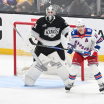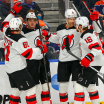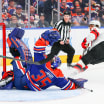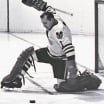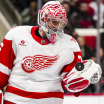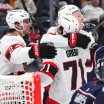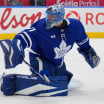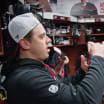MANALAPAN, Fla. --Fights that occur immediately after clean hits, potential video review mechanisms for high-sticking and puck-over-the-glass delay of game penalties, and making mandatory protective equipment for players, were among the main topics discussed on Day One of the NHL General Managers meetings at the Eau Palm Beach Resort & Spa on Monday.
GMs discuss fights after clean hits, other topics on Day 1 of meetings
Video review mechanisms for high-sticking, mandatory protective equipment on table for further action

© Elsa/Getty Images
The 32 GMs broke out into four groups of eight to discuss all the topics. They will reconvene in a larger group setting Tuesday to go over their findings to determine if they want to take further action, whether that's a rule change recommendation, a need for the NHL to emphasize to the officials to enforce the rules are already in place, or to leave well enough alone.
"When you have these breakout groups it's to look to see if there's anything else you can do to make it better, not so much tear it apart because the game for us is not broken, it's in a good spot," Arizona Coyotes GM Bill Armstrong said. "You always want to in those groups makes sure that you don't mess up the game of hockey."
All four breakout groups discussed concerns they have about fights occurring after hits that are determined to be clean and how to regulate against them, if at all. One hundred of the 271 fights this season have been defending a teammate after a hit. Of those 100 fights, 89 came after a clean hit, and 21 instigator penalties have been called.
"They can call the instigator penalty, the question is are they calling the instigator as much as they could," NHL deputy commissioner Bill Daly said. "We saw some stats today before we broke out into the groups that 89 percent of the defending-a-teammate fights are fights after clean hits, and 42 percent of those are penalized either with an instigator or some other penalty. It could be unsportsmanlike conduct. It could be a roughing. It depends exactly what the incident requires. The question is are we addressing these plays appropriately? Do we want less of that in the game? If so, how do we get there?
"I'm not going to say it's a concern because we'll find out tomorrow whether it really is a concern. But a high percentage of the fights in our league come as retaliation to clean hits."
Los Angeles Kings GM Rob Blake said his group discussed potentially increasing the instigator penalty to become a double minor or a major to deter these types of fights. The instigator penalty currently carries a penalty of a two-minute minor, five-minute major and a 10-minute misconduct. If a player receives three instigator penalties in a season, he is automatically suspended for one game.
"We've always found the more teeth, the more severe the penalty is, the less the player is going to do it over time," Blake said.
But Daly said the counter to that was a discussion point in his breakout group with eight GMs They were wondering if the instigator penalty isn't being called enough because it already carries 17 minutes in penalties and a suspension for a three-time offender.
"Some of the discussion in my group was it's so significant that maybe the referees are reluctant to call it because it's so significant," Daly said. "That filters into the mix as well. I don't know if that warrants changing the penalty or reducing the penalty, but it certainly is in the mix."
Changing the penalty would be a change in the rule book, which would need the approval of the GMs, the joint NHL/NHLPA Competition Committee and the Board of Governors.
"I don't think that's the answer," Armstrong said. "I think it's monitoring the way they call it now."
All four groups also discussed increasing the use of video reviews to cover delay of game penalties for puck over glass that are improper, and for high-sticking minor penalties that are the result of a teammate's stick and not that from an opponent.
The NHL currently allows the referees to review at their discretion all high-sticking double-minor penalties that could fall into that scenario. The Situation Room in Toronto is not involved in those reviews.
Daly said it's possible the NHL would institute a different review mechanism for high-sticking and puck over the glass minor penalties, potentially through the use of a coaches challenge or allowing The Situation Room to radio in and call for the review.
"But once you go there, what does it lead to?" Blake said. "Do you now do that for a trip? There's got to be a balance. A lot of these discussions are real general."
There is a growing concern in the NHL about players sustaining potentially catastrophic lacerations from skate blades, the most recent being Edmonton Oilers forward Evander Kane and Dallas Stars forward Tyler Seguin.
Daly said the NHL and NHLPA joint subcommittee has been working on the issue for a while and it's possible the League could look to make cut resistant undergarments mandatory for all players.
NHL-approved cut resistant undergarments, including wrist guards and socks, are already available to all players, but it is not mandatory that they wear it. The League has created educational videos about lacerations and the effect of the cut resistant material.
"The missing step is at what point do you make it mandatory, if you do," Daly said. "Maybe you don't. Maybe all these other things we're doing to educate the players proves sufficient and everyone is comfortable with that. It's a process we've been in for a while and we're continuing through that process."
San Jose Sharks GM Mike Grier said he thinks players will resist mandatory cut resistant materials at first because of the comfort level they have wearing other undergarments.
"But hopefully they can get comfortable wearing it and it can help prevent some injuries," Grier said.
